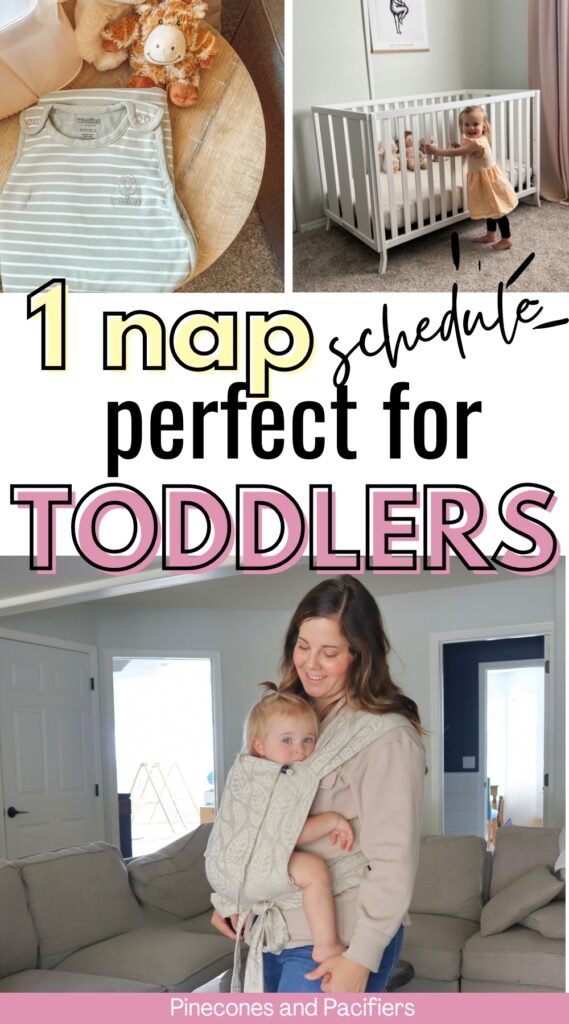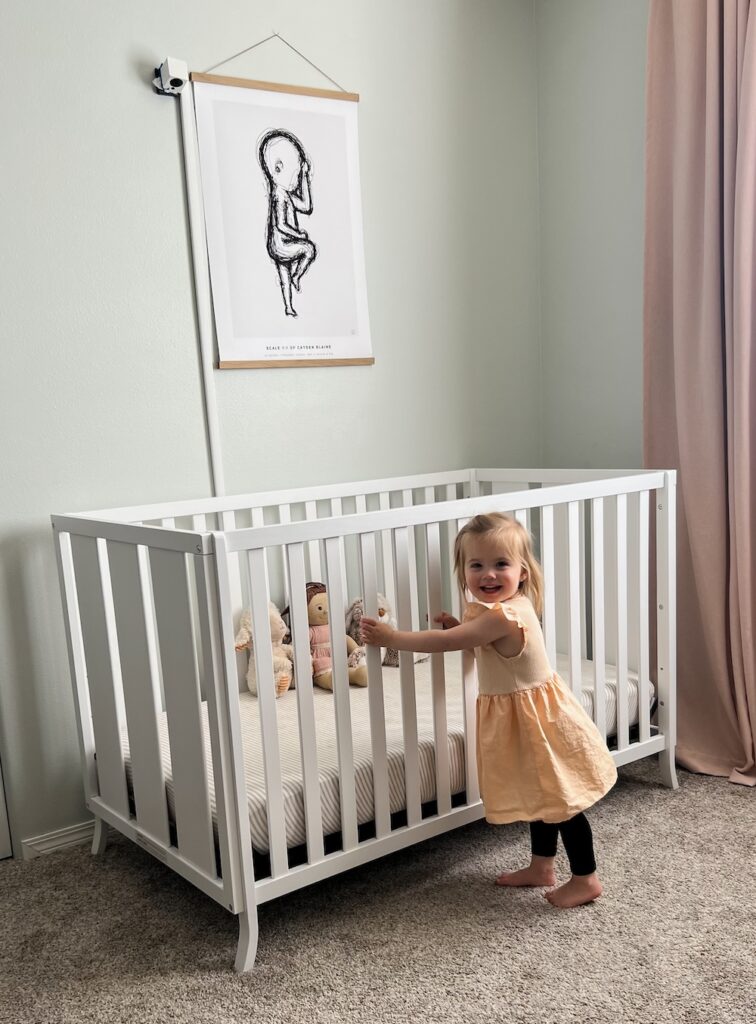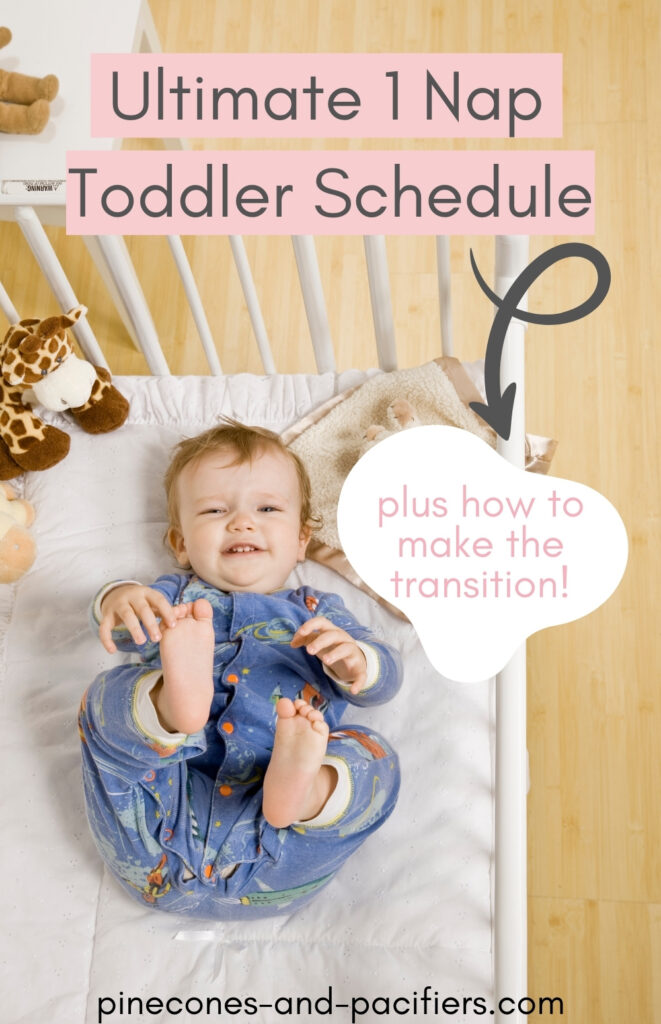The ultimate feeding and one nap schedule for toddlers. When to transition to a one nap schedule, plus how to do make the transition to one nap.
I’m a mom of four and am sharing our ultimate 1 nap schedule that has worked great for all of my kids. There seems to be a sweet spot for when to give the nap so that your toddler isn’t too cranky in the morning, but also makes it to a decent hour at night (and on the contrary, isn’t up super late).
Below you will find when to switch to one nap, the signs your baby or toddler is ready, and the ultimate 1 nap schedule.
If you are just starting out with schedules, you may want to backtrack and read some of our earlier schedules here:
- Simple One Year Old Feeding & Nap Schedule (2 nap schedule)
- 10 Month Old Schedule
- 6 Month Old Schedule
- 4 Month Old Schedule
- 2 Month Old Schedule
All of these schedules follow the eat-wake-sleep principal set forth in the Babywise approach. Check out the book for yourself to learn more! We cannot recommend it enough!

When Should You Switch to One Nap?
Most sleep experts agree that most toddlers can move to one nap anywhere between 12-15 months old. Some toddlers may transition early or later than this age, but as an average, most toddlers move shortly after their first birthday.
My oldest son transitioned to one nap right around 14 months.
This is partly because he did not show any signs of being ready for one nap before this. He loved his naps and was sleeping great overnight as well. Also, partly because of his daycare schedule, which changed to one nap when he finally moved to a new classroom at 14 months.
My younger son and daughter transitioned to one nap around 11 months.
As a mom with a toddler and a baby, I was dreaming for the day when they could nap at the same time. My younger two by nature (as the second and third born) were very flexible nappers and able to handle more wake time than my first could at that age.
We transitioned to one nap a little early mostly because it worked better for our family and also because I felt confident my kids could do this without getting overtired.
The moral of the story is do whatever works for you, your baby, and your family when it comes to nap schedules.

What Are the Signs Your Baby or Toddler is Ready for 1 Nap?
Here are some signs that your toddler might be ready for the 2-to-1 nap transition:
- refusing or fighting sleep at least one of the prior naps
- unprecedented night wakings for no apparent reason
- waking early in the morning (they are tapped out on sleep)
- the second nap is pushed so late that bed time is after 9pm (unless that works well for your family)
If your toddler has been a decent sleeper but starts to experience any of the above sleep problems for no apparent reason – they aren’t teething or going through a major development or change – it might be time to switch to 1 nap.
1 Nap Schedule Basics
There are two basic recommendations when setting up your one nap schedule.
- Total daytime sleep of 13-14 hours (for most toddlers this means a 2-3 hr nap and 11-12 hours overnight).
- Wake time before naps and bed of 5-6 hours
Total Sleep Needs for 1 Year Old Babies
Most young toddlers (12-24 months) need approximately 13-14 hours of total sleep per day. Consider your toddler’s average nap time length when considering how much time to schedule overnight or vice versa. All napping and sleeping should add up to about 13-14 hours in a 24 hour period.
Also remember that all babies are different! My older son was on the lower end of sleep needs at this age and was never a long napper. He normally took a 1.5-2 hr nap and slept 11.5 hrs overnight. My younger son has always been higher sleep needs and routinely takes a 2.5 hr nap with 11.5 hrs overnight.
Another thing that can impact your toddler’s sleep needs is their age when they make the 1 nap transition. A 12 month old making the switch will likely need more sleep than a 18+ month old making the switch. Follow your toddler’s lead!

Wake Time Before Bed for 1 Nap Schedule
In addition to 13-14 hours of total daytime sleep, most sleep experts also recommend 5-6 hours of wake time before your toddler’s nap and before bed. Again, do whatever works best for your toddler and family, but those are great starting points when building your schedule.
This means try to schedule your nap in the middle of your toddler’s day and not a morning or late afternoon nap. That way they won’t get overtired before their nap or nap too early and be overtired before bed.
My 1 Nap Sample Schedule
Below is our ultimate one nap schedule. This is a sample schedule that you can adapt to meet the needs of your toddler and your family.
Keep in mind that if your desired wake-time in the morning is different, or if you need to be out later in the evening, your schedule might be shifted slightly, but the same principals should apply.
- 7:30 am Wake up, drink milk
- 8:00 am Breakfast (move breakfast earlier if your toddler likes to eat right when they wake up)
- 9:00 am Get dressed and ready for the day
- 10:00 am Snack
- 11:00 am Outside or playroom play time
- 12:00 pm Lunch
- 12:45 pm Nap (2-3 hours)
- 4:00 pm Snack w/ milk
- 4:30pm Outside play or run errands
- 6:00 pm Dinner
- 7:30 pm Bedtime routine
- 8:00 pm Bedtime (this may be later if we are out late or if he napped longer, but they rarely go to bed after 8:30 pm)
If you are looking for some meal and snack ideas to help bridge the gap during wake times, check out my posts:
- Easy Fun 1-2 Year Old Meal Ideas
- 6 Fun Toddler Snack Plate Ideas for the Week
- 10 Toddler Snack Ideas
How to Drop from Two Naps to One Nap?
There are essentially two ways to drop a nap; gradually and cold turkey. I’ve found that cold turkey is the best for the 2-to-1 nap transition. It’s hard to do it gradually because the one nap really does need to be in the middle of the day, if you do a morning nap and try to skip the afternoon nap your toddler will be extremely cranky and won’t make it to bed time.
Drop to 1 nap cold turkey and try to fill the morning with as many fun and stimulating activities as you can. Read more on some of our favorite toddler activities >>> Toddler Activities for 1 Year Olds
Push the nap as close to 5 hours from wake time as you can, but if your baby is acting fussy and tired, you may want to lay them down at the 4 hour mark. Keep extending the wake time every day until you get to at least 5 hours after wake up (our sweet spot is about 5.25-5.5 hours after wake up).
For example, if your toddler normally wakes around 7:30am like mine do, your transition schedule may look like this:
Day 1
- 7:30 am wake
- 11:30 am nap (2-3 hours)
- 6:30-7:30 pm bedtime (5 hours after wake up)
Day 2
- 7:30 am wake
- 11:45 am nap (2-3 hours)
- 6:45-7:45 pm bedtime (5 hours after wake up)
Day 3
- 7:30 am wake
- 12:00 pm nap (2-3 hours)
- 7:00- 8:00 pm bedtime (5 hours after wake up)
Continue with this method until your toddler can easily make it to their desired nap time and bedtime.
What if My Toddler has a Short Nap?
If your toddler has a short nap during this transition, don’t panic! Try to keep them awake no longer than 5-6 hours after waking up from their nap and don’t be afraid to put them to bed way earlier than normal, they likely need the added overnight sleep because of the short nap.
Thanks for stopping by! You might also like these related posts:
- Top 60 Amazon Baby Registry Must-Haves for New Parents
- Easy Summer Lunch Ideas for Kids: 3 Fun & Time-Saving Meals Moms Will Love
- Kid-Friendly Blender Cottage Cheese Pancakes (Hulk Pancakes!)
- 3 Must-Have Items for Potty Training Your Toddler
- 9 Easy Toddler Sensory Activities
Pin now to save for later!



Thank you! You’re the only one that said 11 month olds can transition to one nap! My son has always had longer wake windows than the average and every article under the sun discouraged transitioning before 15m. I’ve never doubted my ‘sleep knowledge’ but I starting to and my baby’s sleep was taking the toll. He had been refusing naps, crying like hell broke loose, staying up past 9:30PM for the past 2-3 weeks.
Your post was SO comprehensive that it gave me the courage to go cold turkey (did the same with the 3-2) and he took it like a champ! We still need to adjust a bit but man is he happier! Thank you again!